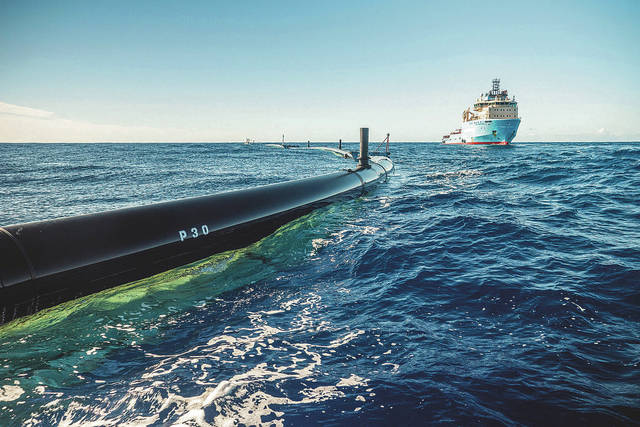An ambitious ocean cleanup device dreamed up by a Dutch entrepreneur is scheduled to land in Hilo Harbor today for repairs.
The Ocean Cleanup Opens in a new tab, a
nonprofit founded by Boyan Slat, three months ago deployed a 2,000-foot-long floating, U-shaped barrier called “System 001” to the Great
Pacific Garbage Patch Opens in a new tab halfway between California and Hawaii. The floating barrier sits on the surface, while a 10-foot-deep skirt attached below catches debris underwater.
In late December, one of its pieces had unexpectedly became detached and started to drift away. The crew immediately secured the wayward piece and reported it to the engineering team onshore.
“We expected to run into unexpected problems,” said Ocean Cleanup spokesman Joost Dubois from Honolulu. “However, we didn’t plan to come to Hawaii.”
Dubois, who was en route to Hilo on Wednesday, said the crew had expected to return to Alameda, Calif., where System 001, also known as Wilson, was assembled. But when the piece broke off, the system was about 1,400 miles from San Francisco Bay and 800 miles away from Hawaii. Based on the weather forecast, the journey to Hawaii seemed safer.
Dubois said the team will determine whether repairs can be made in Hilo or whether to transport the system back to the U.S. mainland.
Hawaii Department of Transportation spokesman Tim Sakahara confirmed he has been in communication with The Ocean Cleanup crew, and that they were expected to arrive today, depending on ocean conditions.
The trouble first occurred on Dec. 29, according to
Dubois, when one of the tow heads on the far end
of the system, which was connected to a floater pipe with two stabilizer frames, all of it measuring about
60 feet, had unexpectedly detached. Crews saw it drifting away and two days later decided to head to port in Hilo.
No system parts have been lost, according to The Ocean Cleanup, and none of the crew members were injured. Before the piece broke off, the crew was
able to collect roughly 4,500 pounds of marine
debris from the garbage patch.
The system was launched in September from San Francisco Bay, and went through two weeks of trials before heading out for the Great Pacific Garbage Patch in early October, according to The Ocean Cleanup’s timeline Opens in a new tab. It reached the patch about mid-October and began collecting debris at the end of that month.
Even then, Slat noted that some plastic occasionally left the system Opens in a new tab, and the crew was trying to understand why. Slat also noted that no interactions with marine life had been observed, which was a concern, including whether some might get caught in the skirt.
The U-shaped floater is supposed to act like an artificial coastline, preventing plastic from floating over it, while the skirt below also would catch debris. The system is outfitted with solar-powered lights, cameras, sensors and satellite antennas that can be tracked.
Slat, 24, was just 17 years old when he came up with the idea for the system during a high school science project in the Netherlands. He figured conventional methods of vessels and nets would take too long, but that ocean currents could be used to his advantage to collect plastic pollution. The idea is to intercept the debris before it reaches coastlines, and to remove it for recycling.
He presented his initial idea at a TEDx conference in 2012 Opens in a new tab, and founded The Ocean Cleanup a year later. The nonprofit, headquartered in Rotterdam, has a staff of at least 80, including engineers, researchers and scientists. The goal is to
deploy a fleet of these systems, which are still a work in progress, to clean up
50 percent of the garbage patch every five years.

